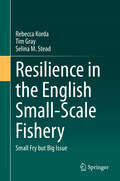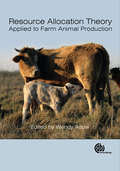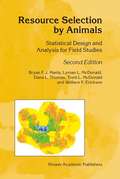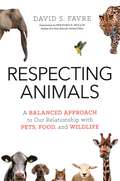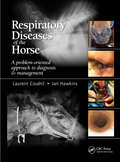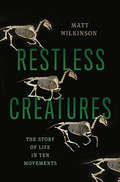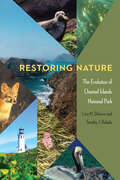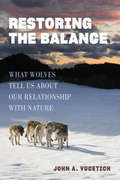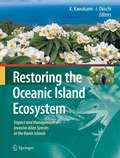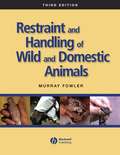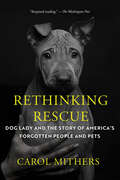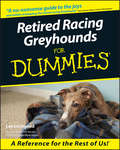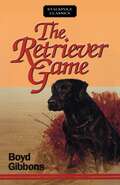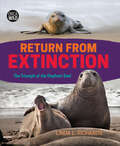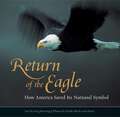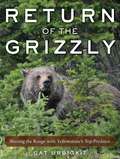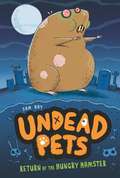- Table View
- List View
Resilience in the English Small-Scale Fishery: Small Fry but Big Issue
by Tim Gray Selina M. Stead Rebecca KordaThis book is a contribution to our understanding of the worrying situation of small-scale fisheries (SSF) which face marginalisation in most coastal countries. The authors explain why SSF are so pressured; how there has been a powerful backlash against this marginalisation during the last 30 years; what are the main ideational currents supporting this backlash; and what is the enduring value of SSF that justifies that support. The authors discuss the major contemporary interpretations of SSF; the challenges facing SSF globally and in England; and SSF’s coping strategies in response to those challenges through the framework of resilience theory. In an innovative analysis, the authors show how there are three kinds of resilience: passive resilience (where fishers are resigned to their adverse fate), adaptive resilience (where fishers make the best use of the opportunities that are available to them), and transformative resilience (where fishers attempt to change the system that faces them). The authors draw on an extensive range of interview data to provide rich insights into the world of SSF, and they discuss a variety of proposals for improving their conditions. The book will appeal to the growing academic and public community that is following with increasing concern the debate about the future of SFF, and to the environmental movement which has committed itself to support SSF as a greener form of fishing than the large-scale industrial sector.
Resource Allocation Theory Applied to Farm Animal Production
by Wendy Mercedes RauwThis book describes resource allocation patterns in natural populations, the costs, preferences and trade-offs of maintenance, growth, the consequences of selection for high production efficiency in livestock species, methods that can be used to quantify resource allocation patterns, and the application of resource allocation theory to improve animal production and wellbeing.
Resource Selection by Animals: Statistical Design and Analysis for Field Studies (Second Edition)
by Trent L. Mcdonald Bryan F. J. Manly Lyman L. Mcdonald Dana L. Thomas Wallace P. EricksonThe current literature on resource selection by animals is a maze of methodologies for data collection and interpretation. Field biologists need a guide through the labyrinth. This book provides such a guide. It gives a clear and consistent framework for the study of how animals select their resources (food and habitat) by taking the reader through different types of study design. It is an invaluable handbook for the field biologist, especially those concerned with the management and conservation of wildlife. The authors have clearly identified the need to pull together the diffuse literature, and biologists will greatly improve their experimental design, methodology, and analysis with this book. The second edition of this popular book has been updated to include many developments in the last few years. There is new material on discrete choice models, the analysis of data from geographical information systems, compositional analysis, Mahalanobis distance methods, and neural networks and related approaches. Resource Selection by Animals: is an invaluable guide for field biologists; provides a consistent framework for study of resource selection (food and habitat) by animals; is a unique guide, and is the only book which covers this critical topic in such depth; and is particularly useful to wildlife managers and conservation biologists.
Respecting Animals: A Balanced Approach to Our Relationship with Pets, Food, and Wildlife
by David S. FavreA legal scholar and animal-rights expert argues for a practical approach to using animals respectfully. In this fresh approach to the animal rights debate, a legal scholar and expert on the humane treatment of animals argues for a middle ground between the extreme positions that often receive the most public attention. Professor Favre advocates an ethic of respectful use of animals, which finds it acceptable for humans to use animals within limited boundaries. He looks at various communities where humans and animals interact: homes, entertainment, commercial farms, local wildlife, and global wildlife. Balancing the interests of the animal against the interests of the human actor is considered in detail. The author examines the following questions, among others: Is it ethically acceptable to shoot your neighbor's dog for barking hours on end? Is it ethical for a zoo to keep a chimpanzee in an exhibit? Is it ethical to eat the meat of an animal? Finally, he discusses how good ethical outcomes can best be transported into the legal system. The author suggests the creation of a new legal category, living property, which would enhance the status of animals in the legal system. This thoughtful, well-argued, and elegantly written book provides readers with a comprehensive and practical context in which to consider their personal and social relationships with animals.
Respiratory Diseases of the Horse: A Problem-Oriented Approach to Diagnosis and Management
by Laurent Couetil Jan F HawkinsThe authors provide a problem-oriented approach to the assessment and management of respiratory illness in horses. The book deals first with the anatomy, function and clinical examination of the respiratory system, followed by discussion of diagnostic tests and procedures. The clinical section is focused around the cardinal presenting manifestation
Restless Creatures: The Story Of Life In Ten Movements
by Matt WilkinsonMost of us never think about how we get from one place to another. For most people, putting one foot in front of the other requires no thought at all. Yet the fact that we and other species are able to do so is one of the great triumphs of evolution. To truly understand how life evolved on Earth, it is crucial to understand movement. Restless Creatures makes the bold new argument that the true story of evolution is the story of locomotion, from the first stirrings of bacteria to the amazing feats of Olympic athletes. By retracing the four-billion-year history of locomotion, evolutionary biologist Matt Wilkinson shows how the physical challenges of moving from place to place--when coupled with the implacable logic of natural selection--offer a uniquely powerful means of illuminating the living world. Whales and dolphins look like fish because they have been molded by the constraints of underwater locomotion. The unbending physical needs of flight have brought bats, birds, and pterodactyls to strikingly similar anatomies. Movement explains why we have opposable thumbs, why moving can make us feel good, how fish fins became limbs, and even why--classic fiction notwithstanding--there are no flying monkeys nor animals with wheels. Even plants aren’t immune from locomotion’s long reach: their seeds, pollen, and very form are all determined by their aptitude to disperse. From sprinting cheetah to spinning maple fruit, soaring albatross to burrowing worm, crawling amoeba to running human--all are the way they are because of how they move. There is a famous saying: "nothing in biology makes sense unless in the light of evolution. ” As Wilkinson makes clear: little makes sense unless in the light of locomotion. A powerful yet accessible work of evolutionary biology, Restless Creatures is the essential guide for understanding how life on Earth was shaped by the simple need to move from point A to point B.
Restoring Nature: The Evolution of Channel Islands National Park (America’s Public Lands)
by Lary M. Dilsaver Timothy J. BabalisOff the coast of California, running from Santa Barbara to La Jolla, lies an archipelago of eight islands known as the California Channel Islands. The northern five were designated as Channel Islands National Park in 1980 to protect and restore the rich habitat of the islands and surrounding waters. In the years since, that mission intensified as scientists discovered the extent of damage to the delicate habitats of these small fragments of land and to the surprisingly threatened sea around them. In Restoring Nature Lary M. Dilsaver and Timothy J. Babalis examine how the National Park Service has attempted to reestablish native wildlife and vegetation to the five islands through restorative ecology and public land management. The Channel Islands staff were innovators of the inventory and monitoring program whereby the resource problems were exposed. This program became a blueprint for management throughout the U.S. park system. Dilsaver and Babalis present an innovative regional and environmental history of a little-known corner of the Pacific West, as well as a larger national narrative about how the Park Service developed its approach to restoration ecology, which became a template for broader Park Service policies that shaped the next generation of environmental conservation.
Restoring North America's Birds: Lessons from Landscape Ecology
by Julie Zickefoose Robert A. AskinsThis accessible book draws on recent research on bird species and their habitats to explain how basic principles of bird ecology and landscape ecology can help us create scientifically sound plans for protecting and restoring the rich diversity of North American birds. This edition includes an afterword that reviews noteworthy literature that has appeared since the first edition was completed in 1999. This new material -- on such key issues as the importance of preserving large expanses of natural habitat, the importance of maintaining early successional habitats, and the habitat requirements of neotropical migrants -- shows how the research on landscape ecology of birds has shaped conservation policy more rapidly than most would have predicted.
Restoring the Balance: What Wolves Tell Us about Our Relationship with Nature
by John A. VucetichWolves on a wilderness island illuminate lessons on the environment, extinction, and life.For more than a quarter century, celebrated biologist John Vucetich has studied the wolves, and the moose that sustain them, of the boreal forest of Isle Royale National Park, an island in the northwest corner of Lake Superior. During this time, he has witnessed both the near extinction of the local wolf population, driven largely by climate change, and the intensely debated relocation of other wolves to the island in an effort to stabilize and maintain Isle Royale's ecosystem health. In Restoring the Balance, Vucetich combines environmental philosophy with field notes chronicling his day-to-day experience as a scientist. Examining the fate of wolves in the wild, he shares lessons from these wolves and explains their impact on humanity's fundamental responsibilities to the natural world. Vucetich's engaging narrative and unique, clear-eyed perspective provide an accessible course in wolf biology and behavioral ecology. He tackles profound unresolved questions that will shape our future understanding of what it means to be good to life on earth: Are humans the only persons to inhabit Earth, or do we share the planet with uncounted nonhuman persons? What does a healthy relationship with the natural world look like? Should we intervene in nature's course in order to care for it? Touching on the triumph and tragedy of how wolves kill moose to the Shakespearian drama of wolves' social lives, Vucetich comments on ravens, mice, winter ticks, and even a life-changing encounter he shared with a toad. Vucetich produces exquisite insight by masterfully connecting his observations to a far-reaching history of ideas about the environment. Combining natural history and memoir with fascinating commentary on humanity's relationship with nature, Restoring the Balance evokes our connections with wolves as fellow apex predators, demonstrating how our shifting views on nature have implications for both their survival and ours. This book will be treasured by any thoughtful reader looking to deepen their relationship with nature and learn about the wolves of Isle Royale along the way.
Restoring the Oceanic Island Ecosystem
by Isamu Okochi Kazuto KawakamiThe Bonin (Ogasawara) Islands, part of a remote Japanese archipelago, are a typical hot spot of biological invasion. Indigenous fauna and flora, which had long evolved in isolation, suffered devastating deforestation and invasion by multiple alien species in the twentieth century. Studies on the impacts of green anoles, flatworms, goats, cats, black rats, and tree and shrub species, among others, have led to new policies in an attempt to arrest the irreversible damage to the island biota. This book provides an overview of the research findings and countermeasures necessary for the successful management of island ecosystems. Based in research conducted over multiple species, this work provides scientists, researchers, students, and policy makers a unique perspective on the integration of conservation projects running simultaneously in the Bonin Islands and on the diversity of their impacts. Restoring ecosystems through the management of alien species is an important conservation issue and the dream that prompted this book.
Restraint and Handling of Wild and Domestic Animals
by Murray FowlerRestraint and Handling of Wild and Domestic Animals, Third Edition offers an introduction to the basic principles of animal restraint and an overview of techniques for vertebrate wild and domestic animals. Fully updated throughout, the third edition also includes new chapters on understanding behavior, training for restraint and handling, and animal welfare and restraint. Now in full color, the third edition of this classic reference is an invaluable tool to recognizing potential danger in restraint and reducing stress in the animal.
Rethinking Rescue: Dog Lady and the Story of America's Forgotten People and Pets
by Carol MithersNOW WITH A NEW AFTERWORD ABOUT THE IMPACT OF THE PALISADES FIRE ON ANIMAL RESCUES IN LOS ANGELESRethinking Rescue boldly confronts two of the biggest challenges of our time—poverty and homelessness—in asking the question: Who deserves the love of a pet?In Los Angeles&’s most underserved communities, Lori Weise is known as the Dog Lady, the woman who&’s spent decades caring for people in poverty and the animals that love them. Long before anyone else, Weise grasped that animal and human suffering are inextricably connected and created a new rescue narrative: an enduring safety net empowering pet owners and providing resources to reduce the number of pets coming into shelters.Rethinking Rescue: Dog Lady and the Story of America&’s Forgotten People and Pets unites the causes of animal welfare and social justice, moving between Weise&’s story and that of the larger U.S. rescue movement. Through captivating storytelling and investigative reporting, Carol Mithers examines the consequences of bias within this overwhelmingly white movement, where an overemphasis on placing animals in affluent homes disregards pet owners in poverty. Weise&’s innovative and ultimately triumphant efforts revealed a better way.As cities across the country witness some of the worst housing crises in history, and as the population of unhoused people and pets continues to skyrocket, Rethinking Rescue offers a story of compassion and hope.
Rethinking Wilderness and the Wild: Conflict, Conservation and Co-existence (Routledge Studies in Conservation and the Environment)
by Stephen Harris Marty Branagan Robyn Bartel Fiona UtleyRethinking Wilderness and the Wild: Conflict, Conservation and Co-existence examines the complexities surrounding the concept of wilderness. Contemporary wilderness scholarship has tended to fall into two categories: the so-called ‘fortress conservation’ and ‘co-existence’ schools of thought. This book, contending that this polarisation has led to a silencing and concealment of alternative perspectives and lines of enquiry, extends beyond these confines and in particular steers away from the dilemmas of paradise or paradox in order to advance an intellectual and policy agenda of plurality and diversity rather than of prescription and definition. Drawing on case studies from Australia, Aoteoroa/New Zealand, the United States and Iceland, and explorations of embodied experience, creative practice, philosophy, and First Nations land management approaches, the assembled chapters examine wilderness ideals, conflicts and human-nature dualities afresh, and examine co-existence and conservation in the Anthropocene in diverse ontological and multidisciplinary ways. By demonstrating a strong commitment to respecting the knowledge and perspectives of Indigenous peoples, this work delivers a more nuanced, ethical and decolonising approach to issues arising from relationships with wilderness. Such a collection is immediately appropriate given the political challenges and social complexities of our time, and the mounting threats to life across the globe. The abiding and uniting logic of the book is to offer a unique and innovative contribution to engender transformations of wilderness scholarship, activism and conservation policy. This text refutes the inherent privileging and exclusionary tactics of dominant modes of enquiry that too often serve to silence non-human and contrary positions. It reveals a multi-faceted and contingent wilderness alive with agency, diversity and possibility. This book will be of great interest to students and scholars of conservation, environmental and natural resource management, Indigenous studies and environmental policy and planning. It will also be of interest to practitioners, policymakers and NGOs involved in conservation, protected environments and environmental governance.
Retired Racing Greyhounds For Dummies (For Dummies Ser.)
by Lee Livingood“The next best thing to having an experienced Greyhound owner living with you.” —Joan Belle Isle, President, Greyhound Project “Anyone who reads this book and follows its guidance will have a happier, healthier dog and be a happier, more relaxed dog owner.” —Hal and Karen Hawley, Greyhound Friends Northwest The Greyhound has been celebrated in song and legend for thousands of years. Nowadays, Greyhounds are bred almost exclusively for racing. In the bad old days, prior to the 1980s, dogs that didn’t make the grade at the track, and those past their primes, were destroyed. According to official estimates, 60,000 of these noble, mild-mannered dogs were destroyed each year! Fortunately, a number of organizations now exist devoted to rescuing these unwanted dogs and placing them in good homes. Thinking about adopting a retired racing Greyhound? Or maybe you’re already sharing your life with one of these charming animals. Either way, this friendly guide tells you everything you need to know to: Understand the Greyhound personality Find a retired racing Greyhound to adopt Choose the right ex-racer for you and your family Educate yourself and your retired racer Give your new pal the diet and exercise it needs Keep your dog healthy and happy for years to come With plenty of good humor and straight-talk, Lee Livingood drawing on her forty-years of experience training adult rescue dogs to cover all the pros and cons of being a retired racing Greyhound owner, and she fills you in on: The amazing 8000-year history of the Greyhound Deciding whether an ex-racer is the right do for you and your family Physical and behavioral characteristics How to get a retired racer used to living in a home and be a companion Dealing with common behavioral and health problems Feeding, grooming, and exercising a Greyhound Fun things to do with your hound Bursting with expert advice on all aspects of living with an ex-racer, Retired Racing Greyhounds For Dummies is must reading for anyone considering adoption or who’s already taken the leap.
Retriever Game (Stackpole Classics)
by Boyd GibbonsWell before dawn on a mid-November morning, a caravan of customized pick-up trucks begins filing out of Duncan, Oklahoma. At that dark hour they appear to be nothing more than campers, but they are dog trucks. On straw and cedar shavings inside these mobile kennels are a half dozen Golden Retrievers, possibly a Chesapeake on vacation, and many, many Labradors. They are going to compete for six days in the most demanding trail of working retrievers—the National Championship Stake.This destination is open to only the best dogs, champions like Hawkeye&’s Smokey Joe, B. B. Powder, Pot Pie&’s W. A. Mega, and Riggo. Boyd Gibbons has followed these dogs and their trainers on the circuit, capturing the lives they lead and the techniques they use on the road to the National Championship Stake. The Retriever Game chronicles the lives and personalities of the men, women, and dogs chasing the Championship. For anyone who loves retrievers, for anyone who enjoys a good dogs story, for anyone who knows a Labrador, Golden, or Chesapeake is an extension of the owner&’s personality, this look at the life on the field trial circuit will be informative and engaging reading.
Retriever Training: A Back-To-Basics Approach
by Robert MilnerThrough gentle training methods learned from Ray Hunt--the original "horse whisperer"--Robert Milner shows retriever owners how to train the hunting retriever by using its own natural tendencies instead of force. Supplemented with the latest scientific research on how dogs learn, Milner's easy step-by-step training regimen uses positive reinforcement to create the perfect hunting and at-home companion. There is no better training method for the hunter who wants a calm, steady, and obedient retriever.Milner, who has been training retrievers professionally for more than thirty years, reverses the trend of difficult dogs and difficult training methods and offers a system every hunter can easily understand and follow.
Retriever Troubleshooting
by Amy Dahl John DahlNationally-recognized retriever trainers John and Amy Dahl (The 10-Minute Retriever) tackle advanced training methods and problem-solving using a dog's innate strengths to compensate for its weaknesses.They discuss how dogs learn at an advanced level while encouraging readers to tailor their training so the dog keeps progressing.Training topics include: how advanced training applies to hunting and to competition; blind retrieves; achieving range and multiple blinds; handling; hazards and formidable obstacles; more disciplined lining; marking; and the use of an e-collar in advanced field work.Problem-solving topics include: the challenges of training high-drive dogs; controlling excitement level and related problems (creeping, breaking, vocalizing, crushing birds, freezing); mouth problems (too rough, eating birds, dropping birds, unwillingness to handle cripples); pace issues (keeping training moving and the dog challenged); inhibitions; problems related to pressure; lack of response at a distance; line manners; and hunting problems (poor perseverance, unwillingness to enter cover).The authors also discuss good general practices and individuality in training, along with specific real-life dog training stories that help readers see how the experts deal with unique problems.
Return from Extinction: The Triumph of the Elephant Seal (Orca Wild #5)
by Linda L. RichardsLess than 100 years ago, the northern elephant seal was thought to be extinct. Today more than 250,000 elephant seals swim in the Pacific Ocean from Alaska to Mexico. In Return from Extinction: The Triumph of the Elephant Seal Linda L. Richards tells the story of their dramatic recovery. Elephant seals were hunted to near extinction for their precious oil before the Mexican government stepped in to protect them. Many people thought it was too late. Even though the life of the elephant seal is difficult and only 20 percent of pups born will make it to adulthood, the species adapted and came back from the brink. They are a true conservation success story.
Return of the Condor: The Race to Save Our Largest Bird from Extinction
by John Moir&“A heart-stopping saga of the rescue from the very brink of extinction of one of the grandest of all birds.&”—Thomas Lovejoy, president of the Amazon Biodiversity Center. RETURN OF THE CONDOR is the riveting account of one of the most dramatic attempts to save a species from extinction in the history of modern conservation. Features a new Afterword by the author.With the condor&’s population down to only twenty-two birds in the 1980s and their very survival in doubt, the condor recovery team flouted conventional wisdom and pursued a controversial strategy to pull the bird back from the brink of extinction. Thus began the ongoing, decades-long program to reestablish America&’s largest bird in its ancient home in Western skies. Award-winning science writer John Moir takes readers into the backcountry to get to know the recovery program scientists as well as some of the individual condors. These are stories of peril, uncertainty, and controversy. Woven throughout these tales of heartbreak and triumph is the extraordinary dedication of the humans who have sometimes risked their lives for this charismatic, intelligent, and social bird. Despite the program&’s remarkable successes, the condor&’s narrative is still unfolding with a number of challenges remaining. This includes the dilemma of lead poisoning among free-flying condors that is a major obstacle to the bird&’s recovery.The new Afterword presents a compelling examination of the progress and continuing adversity facing the condor recovery effort since the first edition of the book was published.Finalist for the William Saroyan International Writing Prize from the Stanford University LibrariesHonorable Mention from the National Association of Science Writers
Return of the Condor: The Race to Save Our Largest Bird from Extinction
by John Moir&“A heart-stopping saga of the rescue from the very brink of extinction of one of the grandest of all birds.&”—Thomas Lovejoy, president of the Amazon Biodiversity Center. RETURN OF THE CONDOR is the riveting account of one of the most dramatic attempts to save a species from extinction in the history of modern conservation. With the condor&’s population down to only twenty-two birds in the 1980s and their very survival in doubt, the condor recovery team flouted conventional wisdom and pursued a controversial strategy to pull the bird back from the brink of extinction. Thus began the ongoing, decades-long program to reestablish America&’s largest bird in its ancient home in Western skies. Award-winning science writer John Moir takes readers into the backcountry to get to know the recovery program scientists as well as some of the individual condors. These are stories of peril, uncertainty, and controversy. Woven throughout these tales of heartbreak and triumph is the extraordinary dedication of the humans who have sometimes risked their lives for this charismatic, intelligent, and social bird. Despite the program&’s remarkable successes, the condor&’s narrative is still unfolding with a number of challenges remaining. This includes the dilemma of lead poisoning among free-flying condors that is a major obstacle to the bird&’s recovery.Finalist for the William Saroyan International Writing Prize from the Stanford University LibrariesHonorable Mention from the National Association of Science Writers
Return of the Eagle: How America Saved Its National Symbol
by Greg BreiningThis is the story of how a nation reversed a &“silent spring&” and saved the bald eagle from extinction. This bird of prey was declared the national symbol in 1782 but, by the 1960s, pollution and development had wiped out all but a few dozen. Grassroots movements started, the American consciousness was raised to all environmental threats, and federal laws were passed to keep the eagle population alive. This stunning book of full-color photographs and touching stories chronicles this inspiring success story with awe-inspiring shots of eagles in flight. There is also a one-of-a-kind directory to more than 150 areas in the nation where eagles are likely to be seen in the wild, soaring once again against the blue skies of freedom. This book is a monument to the efforts that combined animal instinct for survival with the power of the human spirit to change the world.
Return of the Evening Star: Book 2 in Silver Mountain Series
by Diane RiosA mysterious hospital deep in the Oregon woods is sending marauding ambulances into the countryside, looking for new patients. Mowing down anything in their path, the deadly ambulance drivers have forced the people and animals of the land into hiding. Twelve-year-old Chloe Ashton has returned to Fairfax and is desperate to find her mother. Together with her friends—the magical cook Mrs. Goodweather, carpenter Brisco Knot, and clever white rat Shakespeare—she hatches a plan to enter the hospital and stop the bloodshed. At the same time a rumor reaches them from the east: Silas the Stargazer is coming, and he is bringing an army. An animal army.
Return of the Forgotten (Mouseheart #3)
by Lisa FiedlerLoyalties are tested and secrets are revealed in this third book of the epic animal adventure series set in the subway tunnels of Brooklyn, ideal for “fans of Erin Hunter, Brian Jaques, and Kathryn Lasky” (School Library Journal).Felina the cat queen may be gone, but the subway tunnels of Atlantia are still dangerous to all rodents who dwell within the twists and turns. Pup and his spider companion Hacklemesh are lurking in the shadows... Hopper is determined to reach out to his brother-gone-bad, to see if he can talk some sense into the young rodent. But then Hope, the youngest of Zucker and Firren’s new litter, goes missing, and all signs point to Pup as culprit. Meanwhile, Firren is rattled not only by the disappearance of her daughter, but a shameful secret from her past that she’s kept hidden for years. A secret that may hold damaging consequences for not only Firren, but all of Atlantia. How can Pup betray his brother like this? What exactly is Firren hiding? And will the tunnels ever be the same again?
Return of the Grizzly: Sharing the Range with Yellowstone's Top Predator
by Cat UrbigkitConflicts arise when humans and grizzlies are forced into close quarters.The Yellowstone grizzly population has grown from an estimated 136 bears when first granted federal protection as a threatened species to as many as 1,000 grizzlies in a tri-state region today. No longer limited to remote wilderness areas, grizzlies now roam throughout the region—in state parks, school playgrounds, residential subdivisions, on farms and ranches, and in towns and cities throughout the region. Return of the Grizzly tells the story of the successful effort to recover this large carnivore, the policy changes and disputes between bear managers and bear advocates, and for the first time, provides insight to what recovery means for the people who now live with grizzlies across a broad landscape. From cowboys on horseback chased by a charging grizzly, and grizzlies claiming game animals downed by human hunters, to the numerous self-defense killing of grizzlies that occur each year, the manuscript examines increases in conflicts and human fatalities caused by grizzlies in this ecosystem inhabited by humans who live there year-round. Human–bear interactions, grizzly attacks and deaths, avoiding attacks, effects on agriculture, wildlife protesters, the consequences of bear habituation, and more are all covered.
Return of the Hungry Hamster #1
by Simon Cooper Sam HayDumpling the hamster came to a dusty end inside a vacuum cleaner. He suspects that his owner Oliver's parents never admitted to their son that they were to blame for Dumpling's demise. Now the hamster needs Joe's help to reveal the truth - but there's a furry surprise awaiting them at Oliver's house...
